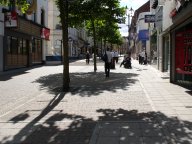
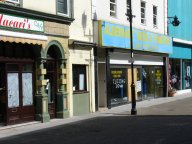
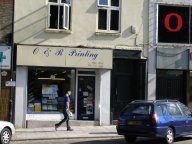
... [after Reigate] the next best position for collecting troops for covering the capital and affording speedy re-inforcements for the Southern Counties, are the extensive heaths at Aldershot, Farnham and Ash ... I do not believe that any waste land possessing the great advantages of Aldershot ... can be found... -- Lord Hardinge, Commander-in-Chief, War Office memo, 26 September 1853
... previous to 1855 it was one of the most pleasing and picturesque hamlets in Hampshire ... -- Victoria County History
The army descended on Aldershot in 1854. It created miles of great dreariness. -- Nikolaus Pevsner, Hampshire and the Isle of Wight
Aldershot has been in a Catch 22 situation for a long time. It is no different to any other market town, it just has an image problem. -- David May, Chairman, Aldershot Retail Action Group



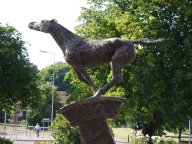 Aldershot is one of those towns where if a bomb
hit it would be regarded as major urban improvement. Up until
the 1950s, 1960s Aldershot was a thriving town, and locals speak
highly of those days, but since then it has been downhill all
the way. In the decade up to the late 1990s, town centre rental income
dropped by 20%. During the day it is a dismal, depressing place, shops
boarded-up, yobs hanging around on street corners spoiling for an
excuse for a fight. At night, Aldershot becomes a no-go area,
gangs of youths and squaddies prowling the streets. For many of
the pubs and bars, sawdust on the floor would be a major
improvement in the decor. The recent addition of large theme
pubs has only served to hasten the decline. A front page article in the local
Aldershot News described one of the town's parks as
the haunt of drunks urinating in the bushes and prostitutes
hustling passers-by (Aldershot News, Friday 12 December 1997).
Aldershot is one of those towns where if a bomb
hit it would be regarded as major urban improvement. Up until
the 1950s, 1960s Aldershot was a thriving town, and locals speak
highly of those days, but since then it has been downhill all
the way. In the decade up to the late 1990s, town centre rental income
dropped by 20%. During the day it is a dismal, depressing place, shops
boarded-up, yobs hanging around on street corners spoiling for an
excuse for a fight. At night, Aldershot becomes a no-go area,
gangs of youths and squaddies prowling the streets. For many of
the pubs and bars, sawdust on the floor would be a major
improvement in the decor. The recent addition of large theme
pubs has only served to hasten the decline. A front page article in the local
Aldershot News described one of the town's parks as
the haunt of drunks urinating in the bushes and prostitutes
hustling passers-by (Aldershot News, Friday 12 December 1997).
In a survey by London-based property consultants Colliers Erdman and Lewis, Aldershot was described as the third most depressed town centre in the country (Farnborough News, Friday 6 February 1998). A report presented to the local council (1 September 1998) emphasised the dire state of the town describing trading performance as poor and the retail economy very fragile - retail sales down on the year (nationally a retail boom), 40% of the retail space empty (25% higher than the national average), 1 in 7 of the remaining retailers expected to close down or relocate (Aldershot News, Friday 4 September 1998; Surrey-Hants Star, 3 September 1998).
Aldershot is mentioned in the Domesday Book (1086). The name is probably derived from Alder, indicating that it was a wet, boggy place. Aldershot, Alreshete, dates back to an Anglo-Saxon settlement.
The Parish of Aldershot was part of the Saxon Hundred of Crondal - Farnborough, Yately, Aldershot, Crondal, Long Sutton.
King Alfred left Aldershot in his will to his nephew Ethelm. In 776 it passed to the monks of Winchester, in whose hands it remained until the Dissolution when it was seized by Henry VIII. Two years later it was transferred to the Dean and Chapter of Winchester Cathedral where it remained (apart from the civil war when it was taken by Parliament) until the nineteenth century.
Had it not been for the coming of the army, and the railways, Aldershot would, like nearby Farnborough, have remained an isolated heathland village.
The British Army was the making, and in recent years the breaking, of Aldershot.
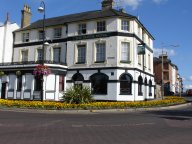 Around the time of the Crimean War, the need was seen for a standing
army, the land around Aldershot was chosen as its site. The army
seized large tracts of heathland around Aldershot (which it still
owns), with Aldershot as its centre. The effect was dramatic.
Aldershot rapidly grew into a Wild West shanty town, with spivs
and prostitutes moving in to help relieve the troops of their
money (some would say not a lot has changed). The population of
both Aldershot and nearby Farnborough underwent a rapid explosion.
Around the time of the Crimean War, the need was seen for a standing
army, the land around Aldershot was chosen as its site. The army
seized large tracts of heathland around Aldershot (which it still
owns), with Aldershot as its centre. The effect was dramatic.
Aldershot rapidly grew into a Wild West shanty town, with spivs
and prostitutes moving in to help relieve the troops of their
money (some would say not a lot has changed). The population of
both Aldershot and nearby Farnborough underwent a rapid explosion.
In 1854, Aldershot consisted of a church, a manor house, a few farms and 163 houses, by 1864 a small town had arisen and a permanent camp had been established. The population of Aldershot in 1851 was 875, by 1861 it was in excess of 16,000 which included about 9,000 military personnel.
Queen Victoria was a regular visitor to Aldershot and a Royal Pavilion was erected for her use. For her Jubilee Review (21 June 1887), 60,000 troops were lined up in the Long Valley - arranged in brigades, the troops stretched from the Basingstoke Canal to Caesar's Camp. Royalty from all over Europe attended, plus VIPs from the British Empire.
There are plans to develop the site containing the Royal Pavilion (Farnborough News, Friday 6 February 1998).
Development, what an ugly word. It should mean enhancement, improvement. When linked with the word property, it degrades to ruination, despoilation, wanton destruction.
The highlight of the social calender was the Aldershot Military Tattoo. This was not a local event or even a national event, but an occasion of world-renown, with people attending from all four corners of the globe. The only contemporary event would be the Moscow May Day Military Parades during the Communist era. Both had the same purpose, to convince the rest of the world that what they saw before them was a world superpower.
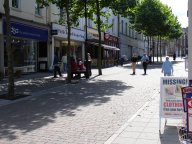 Like many a Wild West town, Aldershot is long past its sell-by
date. The town centre is starting to resemble a ghost town with
few people on the street and many boarded-up shops. Aldershot
appears to have given up the ghost and is waiting for the local
administration to deliver the final death blow.
Like many a Wild West town, Aldershot is long past its sell-by
date. The town centre is starting to resemble a ghost town with
few people on the street and many boarded-up shops. Aldershot
appears to have given up the ghost and is waiting for the local
administration to deliver the final death blow.
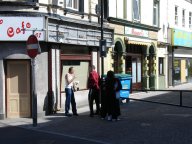 Efforts by the local administration at so-called improvements have been a
series of costly blunders that have hastened Aldershot's decline. These
range from a ghastly shopping centre that destroyed the heart of the town
centre, out-of-town shopping that took away the shoppers, traffic
mismanagement that ground the town centre to a halt, to name but a
few. It became a regular feature for Alan Franklin,
then editor of the Surrey-Hants Star, to lambaste the local
administration, which he refered to as 'Toy Town', for their costly
blunders and cock-ups. The local administration has the reverse
Midas touch - everything they touch turns to dross.
Efforts by the local administration at so-called improvements have been a
series of costly blunders that have hastened Aldershot's decline. These
range from a ghastly shopping centre that destroyed the heart of the town
centre, out-of-town shopping that took away the shoppers, traffic
mismanagement that ground the town centre to a halt, to name but a
few. It became a regular feature for Alan Franklin,
then editor of the Surrey-Hants Star, to lambaste the local
administration, which he refered to as 'Toy Town', for their costly
blunders and cock-ups. The local administration has the reverse
Midas touch - everything they touch turns to dross.
A mobile fast food takeaway was ordered out of the town centre in a silly attempt to clean-up the town's image. Anyone but a fool could see it takes more than the absence of a van selling burgers to clean up the town's act. But then if the truth be told, it was more about oiling the wheels of commerce than polishing Aldershot's tarnished image. [Farnborough Mail, Tuesday 24 February 1998]
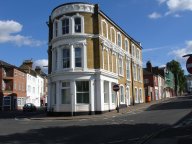 Notwithstanding the damage already inflicted upon Aldershot,
there are plans to inflict yet more damage in the name of Urban
Renewal, seen by many as little more than a poor excuse to spend
more public money (and possibly grease a few palms and line a few
pockets). The centrepiece of this grandiose scheme would
involve demolishing a triangle of land defined by Grosvenor Road,
Barrack Road and Upper Union Street to create an artificial 'Town
Square'. Within this triangle a good proportion of Aldershot's
remaining Victorian architecture has managed to survive,
including the former Imperial Hotel (whose triangular shape
pre-dates New York's Flatiron Building), and a row of run-down shops
that retain many original windows and fittings. Refurbishment
would be the eminently more sensible, and cheaper, alternative. The
obvious candidates for demolition has to be the Princes Hall and
the ugly concrete blocks behind. Any 'Town Square' or gardens
would then lead from the small park opposite the Princes Hall.
Notwithstanding the damage already inflicted upon Aldershot,
there are plans to inflict yet more damage in the name of Urban
Renewal, seen by many as little more than a poor excuse to spend
more public money (and possibly grease a few palms and line a few
pockets). The centrepiece of this grandiose scheme would
involve demolishing a triangle of land defined by Grosvenor Road,
Barrack Road and Upper Union Street to create an artificial 'Town
Square'. Within this triangle a good proportion of Aldershot's
remaining Victorian architecture has managed to survive,
including the former Imperial Hotel (whose triangular shape
pre-dates New York's Flatiron Building), and a row of run-down shops
that retain many original windows and fittings. Refurbishment
would be the eminently more sensible, and cheaper, alternative. The
obvious candidates for demolition has to be the Princes Hall and
the ugly concrete blocks behind. Any 'Town Square' or gardens
would then lead from the small park opposite the Princes Hall.
The Wellington Master Plan, of which the destruction of the Victorian triangle is one small part, is yet another development scheme on the edge of town. If successful, it would be another draw on the edge of town, to the detriment of the town centre, if a failure, yet another blight on the town's landscape. No-one would dispute the need for urban regeneration (a look at the blighted town centre would dispel any doubts), but regeneration has to recognise that Aldershot is first and foremost a Victorian town (with historic military links) and concentrate on restoring its Victorian splendour, so that Aldershot and its inhabitants have something to be proud of, not, as at present, forced to hang their heads in shame.
Summer 2005, Aldershot had deteriorated still further. Within the space of a few months, more shops had closed. Of the shops that remain, many have a scruffy, run-down look about them.
The views of the small, independent retailers is that it is the local council that is to blame, the same council that has presided over the destruction of Farnborough town centre. Independent retailers would like to see Aldershot develop along the lines of Farnham or Alton, quality local retailers. But no one is listening, especially their local councillors.
Retailers also blame the town centre management, which they regard as useless and a waste of taxpayers money, for the town's rapid decline. To employ town centre management is an appalling waste of taxpayers money. People visit a town either because it has what they wish to see, they enjoy its ambiance, or the shops are selling what they wish to buy, otherwise they don't bother to visit the town. Therefore why waste taxpayers money on a useless resource?
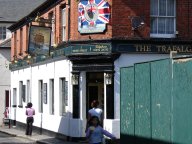 Aldershot used to have many small to medium-sized pubs. A few of these remain, but in the main have been replaced by large bars used for binge drinking. Friday and Saturday night Aldershot is like a war zone as the drunken yobs pour out of the bars onto the streets. Their idea of a good night out is to get pissed out of their brains, throw up in the street and kick someone's head in.
Aldershot used to have many small to medium-sized pubs. A few of these remain, but in the main have been replaced by large bars used for binge drinking. Friday and Saturday night Aldershot is like a war zone as the drunken yobs pour out of the bars onto the streets. Their idea of a good night out is to get pissed out of their brains, throw up in the street and kick someone's head in.
Aldershot has all the classic indicators of a failing town – drunken yobs on the streets, boarded-up shops, charity shops, junk food outlets, takeaways.
On the rough estates away from the town centre, decent folk are plagued by antisocial behaviour and drug dealing. The Police and the local council turn a blind eye, or even try to deny that there is a problem.
Aldershot up until the mid-1970s was an independent borough with its own town council. The Borough of Aldershot received its Charter of Incorporation in 1922. Since the 1970s, following local government reorganisation, it now, together with Farnborough (and very much the poor relation), forms the Borough of Rushmoor.
As to be expected from its long association with the British Army, there are several military museums in and around the area.
Several famous people have loose connections with Aldershot:
Local author Charles Kingsley, rector at nearby Eversley, is best known for The Water Babies (1863). At one level The Water Babies is a fairy tale, at another a brilliant social commentary on prevailing social conditions. Tom the chimney sweep worked for Grimes. He spent half his time up crooked chimneys in the dark, the other happily playing in the street. He knew neither school nor church. His skin was often scraped raw from the chimneys. Grimes beat Tom, then spent his profits in the Ale House. Tom runs away and drowns. He then turns into a Water Baby, where Kingsley in his narrative shows a very good understanding of wetland ecology.
Rudyard Kipling mentions Aldershot in the poem Gunga Din.
The Manor of Aldershot belonged to the Tichborne family from the 16th to the 18th centuries. Aldershot Manor House, Manor Park, rebuilt in 1670 was home to the Tichborne family for 200 years. The house is now used for offices.
One of the oldest buildings in Aldershot is the District Pay Office (junction of Hospital Hill and Wellington Avenue). Built in the 17th century and used as a workhouse, it was taken over by the army in 1854.
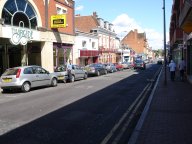 Aldershot used to have an Arcade. Nothing particularly
noteworthy, but the only interesting bit of civic architecture
left within the town centre, something to be proud of. In their
wisdom, the local planners granted permission for its
destruction. To add insult to injury the Arcade has been
replaced by a tasteless modern replica (which has remained half
empty ever since).
Aldershot used to have an Arcade. Nothing particularly
noteworthy, but the only interesting bit of civic architecture
left within the town centre, something to be proud of. In their
wisdom, the local planners granted permission for its
destruction. To add insult to injury the Arcade has been
replaced by a tasteless modern replica (which has remained half
empty ever since).
St Michael's Parish Church dates from the Saxon Period, it was possibly built on an old pagan site. The oldest part of the present church is the tower, dating from the 12th century. The church was enlarged in 1859 to cope with the rapid increase in parishioners due to the arrival of the army. The enlargement uncovered some wall paintings (subsequently destroyed) thought to date from the 13th century. The enlargement also destroyed the original Saxon stone font. An unusual feature of the church is the bricked over graves in the churchyard - possibly a deterrent to grave robbers.
Between Aldershot and North Camp (Farnborough), just before the Iron Bridge crosses the Basingstoke Canal, are the two Victorian military churches of St Michael & St George (Roman Catholic) and St Andrews (Church of Scotland). Above the main entrance to St Michael & St George is a relief of Saint George standing astride the slain dragon.
The Cambridge Military Hospital was built following the experience of the Crimean War, the design strongly influenced by Florence Nightingale. It was intended to serve as a model hospital, its influence can be seen in many of the older hospitals across the country. Its position on the top of a hill was intended to keep the hospital well aerated. The hospital has a ghost, the Grey Lady. Both patients and staff have claimed to have seen her. In the face of strong local opposition, the Cambridge has recently closed down. Apart from the loss of a centre of excellence, against which local civilian hospitals were found wanting, local residents now have to travel much further afield to obtain hospital treatment.
On the southern edge of Aldershot lies Rowhill Copse - a local nature reserve and source of the River Blackwater.
On the western edge of Aldershot lies the heathland of Caesar's Camp, from which on a clear day it is possible to see key buildings in London, including the London Eye on the banks of The Thames in Central London. Aldershot is divided from neighbouring Farnborough by the Basingstoke Canal.
The countryside surrounding Aldershot is unspoilt heathland. To the east of Ash lies ancient woodland.
Such is the international significance of the surrounding heathland that it forms part of the Thames Basin Heaths Special Protection Area. Rushmoor has decided to ignore advice from English Nature and allow development which threatens the heathland, putting Rushmoor on a collision course with the EU. [see Heathland under threat]
Ash and Ash Vale, on the eastern edge of Aldershot, across the border into Surrey, graphically illustrate the effect of the arrival of the railway (1849) the army (1853) and more recently commuters. Ash, corruption of Aesc (at the Ash Tree), was bequeathed by its Saxon owner to the Monks of Chertsey Abbey. The army used Ash Common, heathland to the north of Ash, as a training ground. Prior to a branch line to Aldershot (Aldershot Station did not open until 1870), soldiers marched from Ash Station to their camps in Aldershot. In the space of a decade the population of Ash rose from 838 in 1851 to 1,481 in 1861 and continued to rise. A century and a half ago Ash was a small, quiet village in open countryside, now Ash and the adjacent Ash Vale are little more than urban carbuncles on the edge of Farnborough and Aldershot. Ash Church still remains as the village church. Ash Vale is the northern part of Ash. Ash Green, on the edge of Ash at the foot of the Hog's Back, remains relatively unspoilt. In the 1920s, virtually the whole of Ash Green used to attend the summer garden party at Dene Lodge.
To the north of Aldershot lies Farnborough, to the south the small, historic town of Farnham.
Aldershot Station has connections to Guildford, Farnham, Alton, Ascot and London (Waterloo). Goldline route 1 is a luxury local bus route with contoured, hand-stitched, Italian leather seats, running every ten minutes at peak times (half an hour in the evening) between Aldershot, Farnborough and Camberley. Goldline bus route 1 has proved to be a popular local bus service, albeit a little pricey.
Aldershot is twinned with the French town of Meudon, the German town of Oberursel and the Polish town of Sulechow.